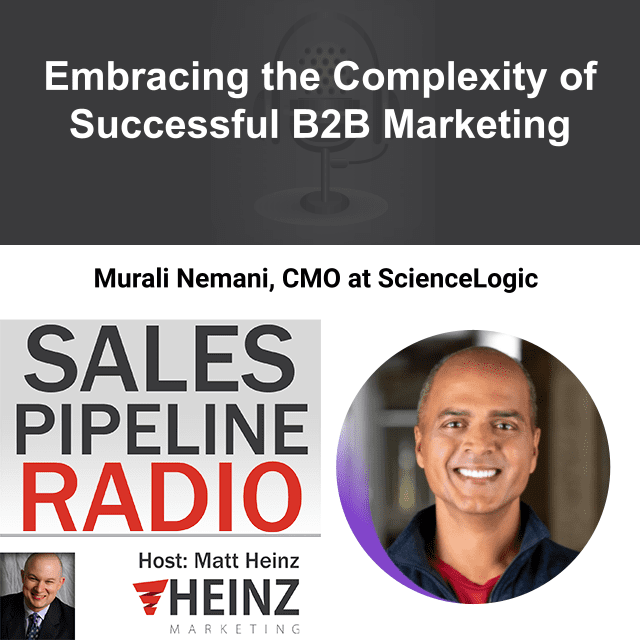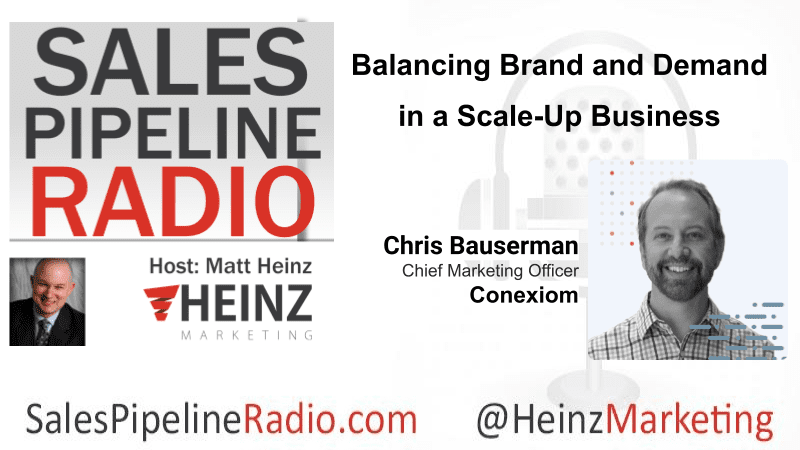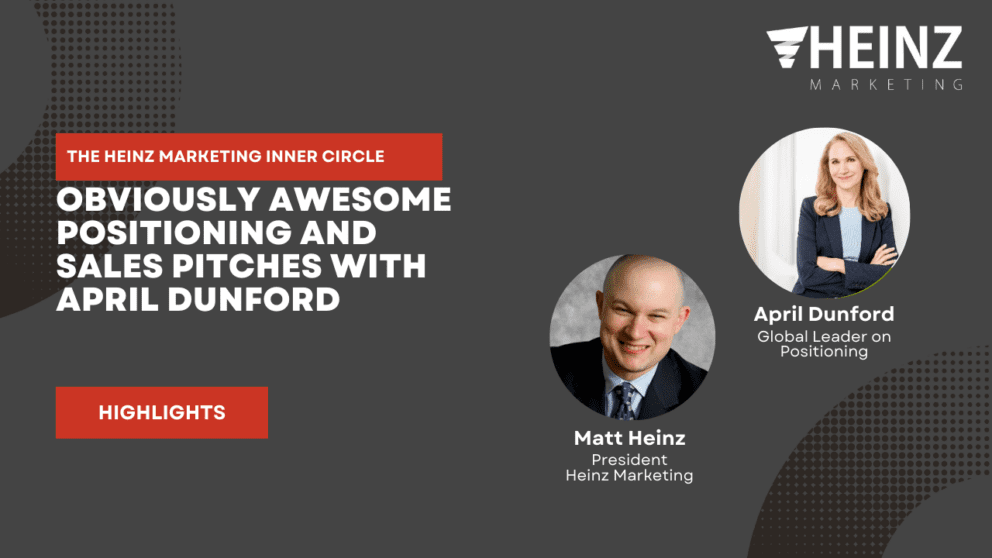Sales Pipeline Radio, Episode 308: Q & A with Murali Nemani @muralinemani

By Matt Heinz, President of Heinz Marketing
If you’re not already subscribed to Sales Pipeline Radio, or listening live every Thursday at 11:30 a.m Pacific on LinkedIn (also on demand) you can find the transcription and recording here on the blog every Monday morning. The show is less than 30 minutes, fast-paced and full of actionable advice, best practices and more for B2B sales & marketing professionals.
We cover a wide range of topics, with a focus on sales development and inside sales priorities. You can subscribe right at Sales Pipeline Radio and/or listen to full recordings of past shows everywhere you listen to podcasts! Spotify, iTunes, Blubrry, Google Play, iHeartRADIO, Stitcher and now on Amazon music. You can even ask Siri, Alexa and Google!
This week’s show is called “Embracing the Complexity of Successful B2B Marketing“. My guest is Murali Nemani, CMO at ScienceLogic.
Join in on our conversation to learn how to keep accounts engaged and progress proactively in the consumerization of B2B business. We uncover:
- How to build trust at the beginning of a buyer’s journey
- The power of 3 key selling strategies: virtual product tours, ROI validation and customer case studies
- How ScienceLogic aims to get the right personalized outcome engagements to targets by building components cross-functionally
Listen in now, watch the video, and/or read the transcript below.
Matt: Welcome everyone to another episode of Sales Pipeline Radio. My name is Matt Heinz. We are recording this. We are usually live on Thursdays at 11:30 Pacific, 2:30 Eastern. If you’re watching this at 11:30 Pacific I’m in Charleston, South Carolina, I’m not sitting here in my basement, but was really excited to have joining us today, Nemani Murali. He is the COO at ScienceLogic. We’ll get right into it. We had some great conversations around sort of this and other topics at the breakthrough conference in December. And it’s an important one as we increasingly in B2B recognized that we’re not selling to buildings. That it’s people and there’s buying committees and there’s decision makers, but the process of buying and the democratization of buying, and I think your characterization was that consumerization of B2B is a real thing.
I think if we don’t address that and put that into our sales and marketing motions, we run the risk of not meeting our cut customers where they are. First of all, thanks for joining the show. And maybe just a quick overview of you and ScienceLogic, and then we can get into it.
Murali: I’m Murali Nemani and I am the CMO of ScienceLogic, I’m based in the Bay Area. So, Matt, I am on the other coast while you’re on the east coast this week! But it’s a pleasure to talk to the community. Our company, ScienceLogic, provides AI Ops solutions for a lot of the practitioners who are building these resilient digital operations. Every business is a digital business today. We here at ScienceLogic end up saying, “If your lifeblood of your business is digital, whether it’s your payment systems, your customer applications, etc. then how do you make them really resilient and almost self recovering and delivering those great customer experiences and employee experiences”. That’s what we do. It’s in the category of AI Ops.
Matt: Love it. Let’s talk about this idea of consumerization, because I think on a surface it looks like we’re sort of running against the account based motions that have been happening where we’re saying like we’re no longer just focused on leads, we need to focus on accounts. We need to focus on who are the right accounts and the buying committees within those accounts. By doing that, we start to say, “There are companies we care about and groups of people we care about.” And yet I have yet to see a building pick up the phone. I have yet to see an entire committee together, attend a sales call, really. It’s individual actions that are really the building blocks of all of this. Talk a little bit about how you see the consumer trends becoming relevant to B2B.
Murali: In that whole motion, while account based marketing or account based X is really sort of this hyper personalized way of engaging with a subset of accounts, you still need to subsequently get that account engaged in meaningful ways. The question is, “Now we’ve got a subset of accounts. We’re getting more intelligence and intel about what the accounts are doing, maybe their profiles, et cetera.” But all ultimately, how do we progress the conversation that engagement with those prospects down to the area where they proactively want to reach out and engage with us? One of the principle problems that we’re struggling through and trying to manage is, how do we get our prospects to take that phone call, to take engagement from the BDR, from the inside sales team, so that they feel confident that that engagement isn’t a waste of their time, or it’s a mismatched expectations between what they thought it was and what we are proposing.
For us, we think about this as this, the consumerization of the B2B experience. If you think back of how you buy a car today, you don’t actually go and visit seven dealerships anymore, do you, Matt?
Matt: I haven’t in a long time. No thank goodness.
Murali: And that’s the same effect that’s happening on the B2B side. People don’t want to talk to seven different vendors and technology providers. They’re basically saying, Let me self drive, self-educate self learn and experience the product almost virtually in a way that allows them to curate maybe down to two or three partners or vendors that they want to talk to. How do you progress that customer, that prospect down that path? And, I think as Forester says, “70% to 90% of the selection process for particular technologies or platforms are done before they engage with the salesperson.” I think the consumerization, then we are sort of exploring a couple of interesting points. One is, you’ve heard of Matt, the free trial type of a thing. And people are doing free trials as ways to get people to kick the tires on the product.
But I think there’s a precursor step that is actually very powerful. And this is the idea of a virtual product tour. And there is a distinction in my mind between a virtual product tour and a free trial. Free trial basically says, “I set it up and I am now driving within my environment with the real product and it’s a level of commitment that is possibly a deeper commitment to go and try something out. But a virtual product tour basically says, “Let me give you a virtual sort of click step by step, where you are driving, but navigating eye product around use cases that are very focused around creating business outcomes that are important to you.” Now you get to see the entire thing, but you’re not actually in a physical build-out and so forth that you might be having to deploy AWS resources to go do.
That is one example of where customers can see the actual instance of that product and around the use cases and they’re driving and navigating and they get that feel like this is either something that is good for me, or this is not what I thought the product was going to do.
Matt: I love that. And I think that what you’re doing there is you’re creating transparency for the buyer, for the prospect. You’re helping them understand what’s behind the curtain at what they’re getting into. I think you’re reducing risk and uncertainty. And I think a lot of times look, the status quo is a powerful thing man its just pulling us back to where we are. If there is friction in between you and the status quo, even if it’s like, “Oh, I’m not really sure what that looks like, I’m not really sure how easy it’s going to be user you say, I don’t need to use IT.” This idea of the virtual tour or the deep fake in some cases environment can work a lot. And I think one of the things that that brings in is the fact that you’re building trust through not a single act, but a body of work. You have to do multiple things to build a, “Across all of these experiences, I feel like this is a company I trust.”
Murali: There’s essentially three kind of things that you can do to build that trust. The first one is this virtual product tour that gives you an instance of what the product can or cannot do to your satisfaction around use cases that are important to you. The other one is the idea of a ROI calculator, which is the economic buyer interest. One is a technical buyer’s interest, the other is an economic buyer. And they say, “Look from an economics perspective, what is the investment thesis for making this right. And how does that play out within my budget profile?” If you can build out a, not just a classic ROI calculator type of thing Matt, but the ability to validate that, one of the pitfalls is, unless you have that validated by some third party, it can look like you’re an arms dealer selling arms and you’re telling them the justification of buying your arms.
Murali: So, I think in that sense, we’ve done a partnership with Forrester where Forrester goes and economically validates with our customers, the legitimacy of the ROI calculator, and then we use that as the basis for how we power this web based calculator. Then the customers come in with slider bars around what their criteria is, and they can then see the economic validation from Forrester, which then they can take to the CFO and say, “look now not only does this product meet my needs through the virtual product tour. Now I can take it to the economic decision committee and say, this is how Forrester has validated across four different customers, the gains that we’re talking about.”
The last bit is essentially the idea of customer case studies, but customer case studies not focused around the technology, but around the business outcomes that were created, which further legitimizes the economic incentive to go make that. I think this is the progression that I see that moves the prospect with more trust and confidence that this is either a good fit or not a good fit. And hopefully makes it easier for the BDR and the inside sales teams to get that first meeting, to get that deeper engagement for a demo and proof of our value.
Matt: We’re talking today on Sales Pipeline Radio with Murali Nemani, he’s the CMO at ScienceLogic. Talking about different flavors of the consumerization of B2B and sort of how to land the plane really on that. I think your last point about case studies and the orientation of case studies is really important. Your product and service is not the hero. Your customer is the hero. Their outcome is the hero. You’re the sword. You may be the tool that they use to get there, but more they see themselves as the hero, the more these see themselves in the story, in the outcome, as the hero, as the success at the end of the movie, that’s what you want. Let’s talk about like how you execute this. Because you there is no single piece of content. There is no one webinar to end all webinars where you’re going to get a cold prospect to show up, and then you totally sold to the end. And I mentioned earlier, body of work, how do you start to execute this across sales and marketing motions in a consistent way?
Murali: There’s two parallel motions, maybe three parallel motions. One is obviously there is the body of content in supporting this experiential kind of insights. Your product marketing team has to do a lot of heavy lifting in building out the virtual product tour, your product marketing team then has to do heavy lifting around the economic, calculator plus the case studies that are about business outcomes. There’s a group that has to do that. Then there’s a group that’s runs your ABM campaigns, which is your classic demand engines. They are high, super focused on trying to get the right personalized outcomes engagements to the targets, which then pull them into the experience that you’re trying to deliver on your website to help them nurture them, develop them as they progress them through the product marketing assets.
The last step is the BDR organizations in the way they take that intent data, how they take the consumption of which assets they’re spending time on. Which solutions are they exploring in the virtual product tour. How are they then using that to look at an economic calculator which says, I see the domain that they’re operating in. I see what kind of economic gains that they’ve been looking for. And now the conversation can be accelerated by the BDR or the inside sales team with all this information about the prospects particular scenario. That is the connective tissue, if you will, between those through groups to move this prospect further down the funnel.
Matt: Easy for us to say here. A lot of cases, I’ve seen a lot of CMOs say, “Yeah, I know this is the right approach.” But then their sales team or their board has read a certain sales book that says, “No, just make enough calls, just make enough calls and send a bunch of like scorch shirt emails, and you’ll get enough people into the pipeline.” Let alone all the people you just pissed off that you tried to push too far, too fast. There is a culture change component to making this possible. For the marketing leaders that are hearing this and saying, “I get it, but how do I get my board behind it? How do I get my CEO behind it?” How do you teach that culture change internally? Where do you start?
Murali: I think it starts with, one is, people like to be shown a vision for how the world is moving towards a particular direction. I think the board gets it that when you talk about the consumerization of the B2B experience, they get it. Because every time I tell my board, “Do you still buy visit seven dealerships?” They’re like, “No.” I think that’s exactly what our customers are doing to us. They don’t actually go meet seven vendors. They do all the is homework well ahead of their time. When I make that argument, they get it viscerally because it’s part of their behavior and they understand that they can see themselves, they’re our prospects and our customers in that. That’s argument number one.
Argument number two is then painting a picture of if you want to empower and enable the aspect to be self-serving. What does that vision look like? And then being able to articulate that either through some sort of a visual experience you can put together of what this experience we just talked about and showing that to them. Because now that video is worth a gazillion words. And that is the second way. And then the third way is then building these different components together, across the sales, marketing, the customer success team so that it’s now consistent across those different, and that takes internal buy-in from your sales teams, your BDR leadership, your product leadership, et cetera, to make that all come together. And that’s I think is part of, if you’re going to make this journey, go make the journey with buy-in from those organizations.
Matt: I love that. I think if you’re facing headwinds internally, you’ve got a couple things working your advantage, you have analogies, for sure. I think you brought up the car buying experience a couple times. Think about like what the car buying experience would look like if it was run like a typical B2B sales process. You can’t get in the car until you buy it. You want to test drive it? You can do that after you’ve committed to buying it. It sounds ridiculous because this is what we’re used to with a car, but how is it not the same with a major software or service?
You can literally pick your colors, you can price your car. You can look at peer to peer tope reviews. You can see videos of the 360 degree, inside, outside, that’s what to modern car buying experiences. And I think that’s what we have to do for B2B software.
Matt: You can’t get in the car until you go through a four day orientation on how to drive the car. We got to teach you, we got to onboard you before we can let you anywhere near the car. But also I think for other people that are saying this is a challenge, I think to… But I think there are so many companies that are doing this and seeing results. Its exciting to hear Murali what you guys are doing at ScienceLogic to really move the needle on this. I know we’re about out of time, but thank you so much for joining us today, sharing a little bit about your perspective on this. Certainly very enlightened and love seeing some of the examples and output of what you guys are producing.
Murali: Give us a little bit, we’ll bring this all out in the coming months. This is not a quick thing that you do overnight, but I think if you have the right vision and the right fortitude, and you can rally the support of the organization, I think this is where as a community, we need to move towards that consumerization of the B2B experience. And we’re going to give goodwill to our prospects, our customers, and in the way they learn about what we have to offer.
Matt: I love it! Thanks so much for joining us today. Thank you everyone for watching virtually from Charleston, South Carolina. Thanks for watching. Listen to the Sales Pipeline Radio. We’ll see you next week. Take care.
Murali: Thanks everyone.

I interview the best and brightest minds in sales and Marketing. If you would like to be a guest on Sales Pipeline Radio send an email to Sheena@heinzmarketing.com. For sponsorship opportunities, contact Cherie@heinzmarketing.com





